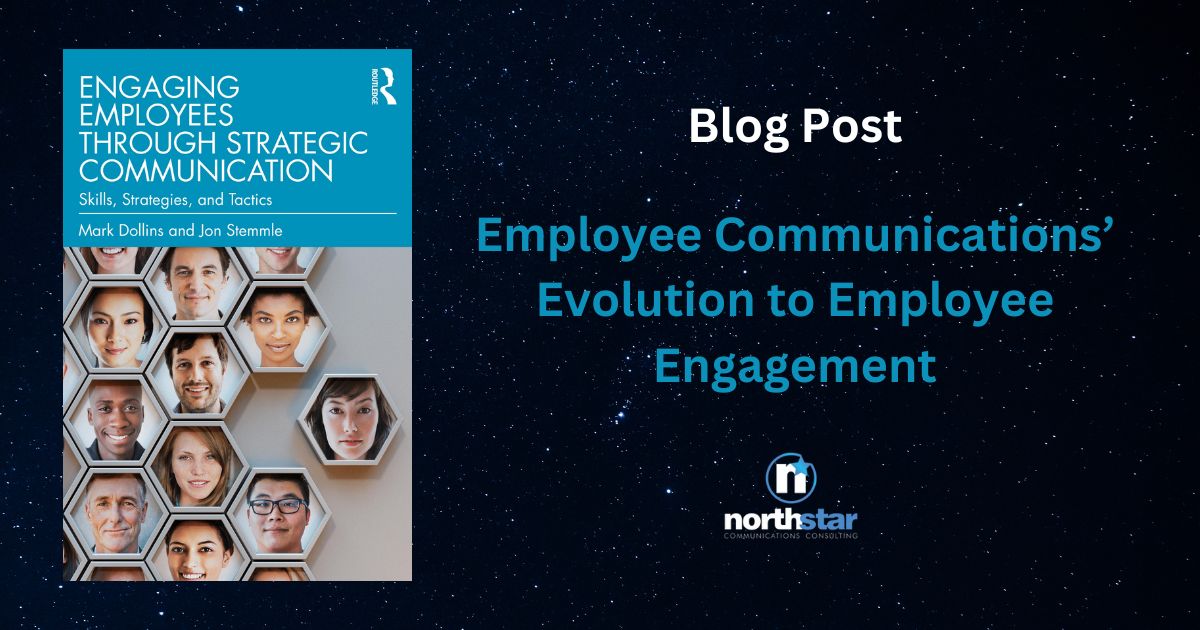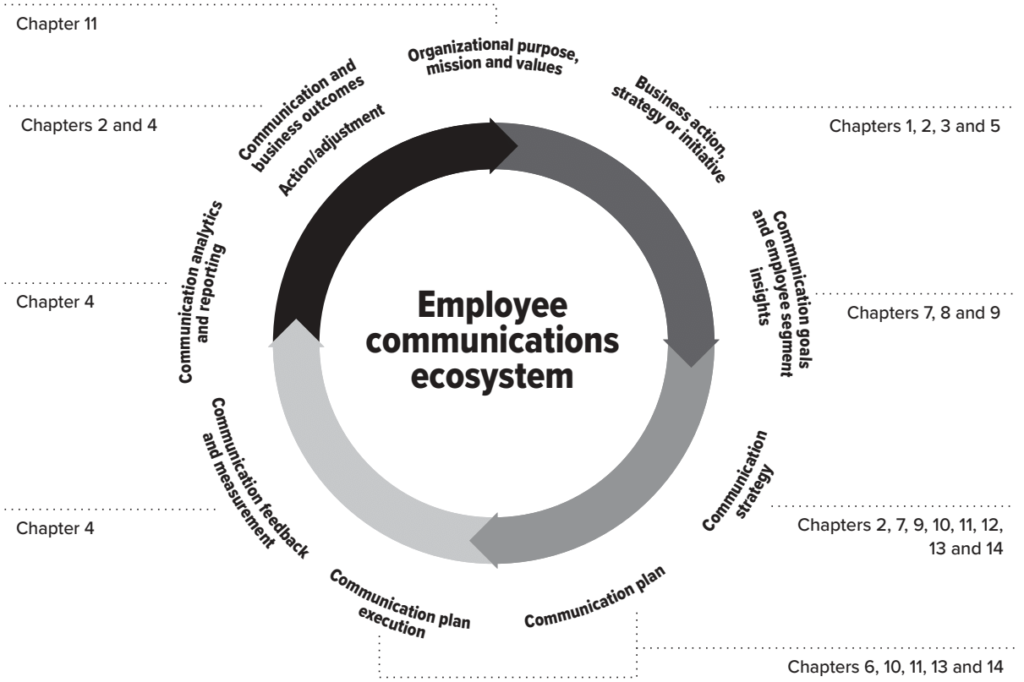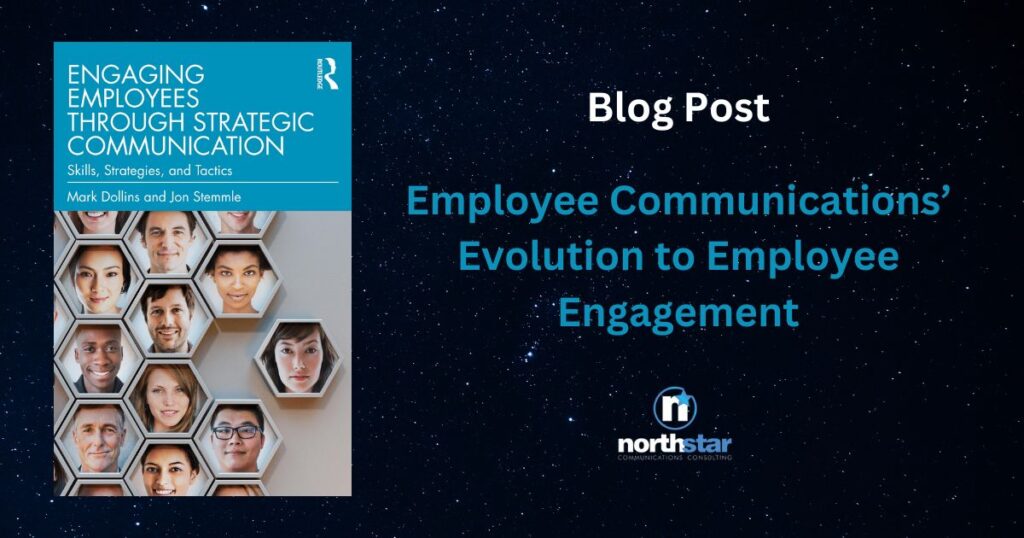
This blog post briefly summarizes Chapter 12 of the book Engaging Employees Through Strategic Communication by Mark Dollins and Jon Stemmle. Visit engage-employees.com to grab your copy today.
Unlike the early days of employee communications – which generally featured one-directional media broadcasting the company’s agenda – contemporary employee communicators have evolved to use far more dynamic and strategic models. Employee communications professionals today understand that connecting with employees demands multi-directional exchanges between employees, their peers, their leaders and a range of other stakeholders. Continuous feedback loops are used more than ever to understand how internal stakeholders are responding to content, and measurement has become commonplace. Communication that encourages employees to engage with content, respond to it and apply it, has become the standard.
As critical as it is for employees to engage with content, it’s a means to another end that carries far more importance for business leaders. CEOs and other C-suite executives simply don’t care about how many articles have been published in the company newsletter or how many team members attended the latest town hall.
What leaders care about is engagement with work, and that’s where employee communicators increasingly are spending their time, energy and financial resources. This shift fundamentally illustrates how practitioners have moved from roles as writers and reporters to roles as connectors and engagement professionals.
Employee engagement has often been described in the corporate world as the special sauce that prompts “discretionary effort” – that extra effort any employee chooses to make in the work he or she does. Whether it’s working extra hours, cleaning equipment or work surfaces when no one asks, or spending that extra moment connecting with a customer, engagement ideally reflects a deeper commitment from an employee to the organization’s mission, vision and values.
There are as many definitions for engagement as there are organizations who strive to improve it. Employee engagement is viewed as a critical driver of business success in today’s competitive marketplace. If employee engagement is done well, it can help companies retain employees and increase their production and inspire loyalty among customers.
It’s neither easy nor commonplace to keep employees engaged with work. Every year over the last decade, global analytics and advisory company Gallup performed an employee engagement meta-analysis looking at employee engagement and performance data from more than 100,000 teams worldwide. Based on the analysis of this data, Gallup in 2019 reported that worldwide only 15% of employees are engaged. In the United States, just 35% of the workforce was engaged, which it defined as being involved in, enthusiastic about, and committed to their work and workplace. Gallup reports its analytics show that employee engagement drives business improvement, from lower turnover to higher customer engagement to higher profitability. Specifically, it reports higher employee engagement leads to:
- 41% lower absenteeism
- 24% lower turnover (high-turnover organizations)
- 59% lower turnover (low-turnover organizations)
- 28% less shrinkage
- 70% fewer employee safety incidents
- 58% fewer patient safety incidents
- 40% fewer quality incidents (defects)
- 10% higher customer metrics
- 17% higher productivity
- 20% higher sales
- 21% higher profitability
Measuring Employee Engagement
Just as there are different definitions for employee engagement, there are different metrics for measuring it. More often than not, organizations use organizational health surveys, and/or pulse surveys (used more frequently, but with smaller samples – often between one- to two-year cycles for broader organizational health surveys) to assess employees engagement levels, and which drivers are, and are not, working.
For employee communicators, it’s critical to understand what metric, or set of metrics, are deemed critical for defining employee engagement in their organizations and then assessing how communications can best support improvement with any, and all.
The bottom line is that communicators need to know what their organizations value for assessing engagement, and align communications and strategies to those priority areas. They need to be fully engaged in organizational health and pulse survey measurement efforts. Ideally, that includes inserting a question or two that is specific to communications that employees receive. Often, questions in those kinds of surveys are closely guarded by owners in other functions, so communicators must be clear, concise and persuasive in explaining why communications-specific questions must be included.
Are you curious to learn about connecting employee engagement to the Employee Value Proposition and employee experience while building an employee engagement communications plan? Get Your Copy Of The Engaging Employees Through Strategic Communication Book Or Contact North Star Communications today.

The diagram above shows the different topics covered in the book. Take advantage of the opportunity to enhance your organizational communication strategy and engage your employees effectively by getting your hands on the highly recommended book, Engaging Employees Through Strategic Communication by Mark Dollins and Jon Stemmle. Piqued your curiosity? Want to know why change communications, Block Chain, Artificial Intelligence and employee activism will shape our near-term future? Visit engage-employees.com to grab your copy today.
If you’re looking for expert guidance in implementing change communications, talent development, and coaching in your organization, look no further than North Star Communications Consulting. Contact us today to schedule a free consultation and take the first step toward transforming your organizational communication approach.


